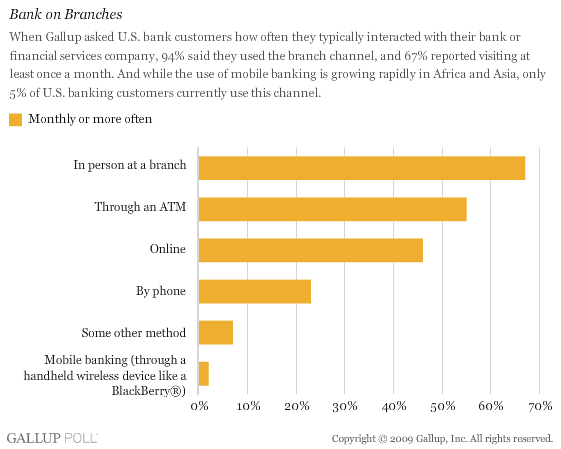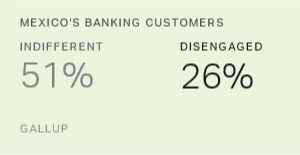The rise and fall of various consumer channels has been a thorny topic in the banking industry for years. Financial services providers have tried everything to improve efficiency by altering customer behavior, from begging and pleading to incentives and penalties -- remember the first bank to charge to use a teller?
Banks may be forcing customers to interact with them using their least preferred option, and that can breed a feeling of helplessness -- or worse, resentment.
What's typically missing from those efforts is the customer's point of view: How do customers want to interact with their bank? If banks aren't providing customers with service options that they actually want, rather than what's convenient for the bank, then they're missing opportunities to engage customers. What's more, they may be forcing customers to interact with the bank using their least preferred option, and that can breed a feeling of helplessness -- or worse, resentment.
So how are banks supposed to find out what their customers want? By asking them, which is what the Gallup Panel did recently. Gallup surveyed more than 38,000 customers of more than 175 financial institutions throughout the United States. What we learned may surprise you -- and challenge your assumptions about how your customers want to interact with your bank.
Branches
One of the most surprising results was that most bank customers still bank the old-fashioned way -- at branch locations. In an age of ubiquitous ATMs and a proliferation of online banking options, 94% of customers use the branch channel, and about two-thirds (67%) visit a branch at least once a month.
This finding suggests that banks would be shortsighted to shift their focus and resources away from their branches. Although branches take significantly more time and money to staff and operate than any other channel, most customer interactions occur in branches. Driving, luring, or forcing large numbers of customers to use other channels isn't likely to be easy.

ATM
Remember the good old days when, if you needed $20, you had to go to a bank during business hours, fill out a form, stand in line, show ID, and ask politely for cash? Actually, those days really aren't so long ago; in fact, most customers still visit a branch to do their banking. Forty-four percent of bank customers visit an ATM less than once a month -- or never visit at all. Only about one-third of customers (37%) visit an ATM once a week or several times a month. This might have something to do with ATM fees or the alternative use of debit/credit cards. But it does suggest that if your bank wants to encourage customers to use your ATM network, you may need to craft a clear, customer-focused ATM strategy.
Online
Many banks have had high hopes for their Internet channel. Unfortunately, many banks have seen those hopes dashed. While use of the online channel is growing, 46% of customers never visit online. Among online users, 32% visit your Web site weekly or more often, while 21% visit less than once a week.
There are ways to make Web sites more user friendly for your customers, including offering simple interfaces, a wider variety of services that can be conducted online, and highly skilled customer support that's available 24/7. But significant improvement in those areas may take more resources than many banks realize.
Banks shouldn't assume that creating an online channel will reduce their operating costs. Like any new channel offering, online banking will require an initial investment to become viable -- and it may take time for customers to become comfortable using it. But I believe that as time goes on, more customers will feel comfortable conducting their financial service business online.
By phone
One quarter (25%) of U.S. banking customers never call your bank, and 53% call less than once a month. Interestingly, only one-third of 1% of your customers call daily -- but it's likely that your bank's employees know them well.
Perhaps customers find a personal connection in brick-and-mortar banks that they don't through other channels.
The reason that so few customers call your bank varies. But overall, consumers don't seem comfortable with this channel. There could be many reasons for this: Perhaps customers don't know what business they can conduct over the phone. They may assume that they'll need to provide personal information (such as their account number) that they may not have on hand when they want to call. They could be cautious about discussing financial matters on the phone with someone they don't know. Or they may fear long wait times or getting stuck in an endless loop of choices in an automated telephone screening system. Regardless of the source of their concerns, for customers, perception is reality.
Banks that want to encourage customers to call might do well to publicize the variety of services they offer, their ease of use, and the specific forms of information customers need to have ready when they call -- but I'd only recommend this if your bank does offer a variety of services with easy access. Unless banking by phone is genuinely quick and easy, you'll risk jeopardizing your brand promise by promoting a channel that customers may resist using.
Mobile
Mobile banking, or M-banking, is much more common outside the United States and is growing rapidly in Africa and Asia; it's especially popular in Japan, South Korea, and Singapore. In fact, in South Korea, you can buy 159 different phone models that include banking capabilities. In those countries, customers use their phones for retail purchases, paying bills, sending remittances, and transferring funds -- they can even have their paychecks deposited directly to their mobile accounts. And M-banking is becoming increasingly common in developing countries, where branches and banking networks often have a reduced profile yet people still need reliable financial services.
M-banking has yet to hit big in the United States, though; 95% of bank customers never use mobile banking. But of the customers who do use this channel, nearly 5% use the service daily, and another 17% use it at least weekly. These small percentages could reflect limited national offerings. They may also suggest that bank customers don't know what mobile banking options their bank offers or how to use mobile banking on their cell phones.
Under the roof
It seems clear that no matter what channel banks would prefer customers to use, most customers still prefer banking at a branch location. That may seem counterintuitive to those of us who assume that what customers really want is speed and convenience. Banking online or by cell phone might be faster and more convenient for consumers -- yet customers continue to want to talk to humans face to face, and bankers must take note of this.
What makes customers want to walk or drive to a branch location? Perhaps it's because customers find a personal connection in brick-and-mortar banks that they don't through other channels. Regardless of the reason, there's little doubt that customers want to be emotionally engaged with their bank -- but on their own terms.
Gallup has been studying customer engagement -- a powerful attachment to a brand or product -- for decades. We've found that engagement is based on five hierarchical needs (starting at the base and moving up):
- Rational satisfaction: The feeling that that the products and services fulfill the brand promise, making the customer likely to continue using them and likely to recommend them.
- Confidence: The brand delivers on promises and can always be trusted.
- Integrity: The brand resolves problems fairly and treats customers fairly.
- Pride: The brand inspires pride and treats customers with respect.
- Passion: The brand is "perfect for people like me," and customers go so far as to say they can't imagine a world without that brand.
Rational satisfaction must be met first, of course, because that's the baseline expectation. But as banks fulfill each need after that, they inspire more and more customer engagement. They also reach a higher pinnacle of profitability. Based on analysis of Gallup's extensive database containing thousands of customer engagement ratings, fully engaged customers represent a 23% premium in terms of share of wallet, profitability, revenue, and relationship growth, while actively disengaged customers represent a 13% discount.
A business impact analysis of customer engagement for a large regional bank showed that among repeat customers (those who had visited a branch location twice and interacted with a branch associate on both visits):
- fully engaged customers increased their account balances by 9%
-
customers who moved from disengaged to fully engaged increased their account balances by 12%
-
customers who moved from fully engaged to disengaged decreased their account balances by 7%
-
customers who were disengaged following both visits decreased their account balances by 8%
Expand your bank's channels
It pays to engage customers. And it appears that customers are going, of their own volition, where they feel more apt to be engaged -- branches. But that doesn't mean that branches are the only channel that can engage customers.
It's quite possible to build engagement with other banking channels. The solution is to discover how to meet your customers' needs for emotional fulfillment in the channels you want to promote. A good way to start this process is by asking these questions:
- What is your bank doing to build engagement in every channel it offers?
- Are resources allocated to best build customer engagement the way customers want to interact with your financial institution?
- What effect do your employees have on successful customer interactions in each channel? How do you measure and manage it?
- Finally, what is your bank leaving on the table by making management decisions without measuring, considering, and linking the voice of the customer and the voice of the employee?
You probably won't answer all those questions before lunch. These are serious matters that will take time -- and considerable thought and research -- to resolve. For starters, I recommend thinking about how your bank is creating engagement in any channel. That's always a good place to start. Customers want to tell you what they want. Are you listening?
Survey Methods
Results are based on a Gallup Panel study and are based on mail and web surveys completed by 42,85 national adults, aged 18 and older, conducted 8/13-2009 to 9/23/2008. Gallup Panel members are recruited through random selection methods. The panel is weighted so that it is demographically representative of the U.S. adult population. For results based on this sample, one can say with 95% confidence that the maximum margin of sampling error is ±1 percentage points. Margins of sampling errors vary for individual subsamples. In addition to sampling error, question wording and practical difficulties in conducting surveys can introduce error or bias into the findings of public opinion polls.

